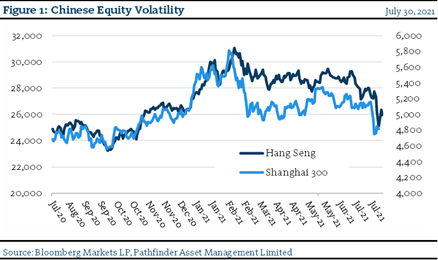China Contagion?
We have been on a bit of a break from the weekly commentary while we sent out our quarterly and semi-annual fund notes. During that time, there has been some volatility in financial markets. Financial professionals often opine about having assets spread across different asset classes, sectors and geographies in order to benefit from diversification. The theory is, if there is an issue in one area or security type, it will generally be contained to that area and not impact others. However, as time has passed and as we have become more integrated with trade and technology, we anecdotally find that financial assets are becoming more connected, and subsequently more correlated, with one another.
In China, over the recent weeks, there have been some interesting developments, which so far, have had limited impact on other parts of financial markets but we are watching quite closely. A short summary of the issues is below:
- A Variable Interest Entity (VIE) is a structure that has been in place for years where, through a system of contracts, a Chinese company is able to list its shares on a foreign exchange. This system has recently been challenged by the Chinese government and consequently the US SEC as well. The change will make it harder for foreign capital to invest in Chinese companies. We suspect this is by design as China turns inward for its domestic financial needs.

- Evergrande Group is the largest property developer in China, with investments in businesses spanning multiple industries. It is also one of the top 10 largest corporate debt holders in the world (USD$100 billion). The company is undergoing a liquidity crisis and its bonds are trading at half of their normal value.
- Education and Labour Regulations: Similar to the VIE issue, the Chinese government has identified that education and housing costs are too high and general wages are too low to support young people who would like to have families. This is critical to help reverse its long brewing demographic problems. The government views this as a long-term risk and has put regulations in place to reduce educational costs and provide workers with more rights. This has impaired the profitability of the companies that operate in those industries.
“This means that” we believe that in long-term, there are still tremendous opportunities for investing in China but that the government management of essentially all parts of society can causes uncertainty for investors. We also believe that these are short-term issues and that companies will be able to normalize their operations over time to provide substantial value.
National Instrument 31-103 requires registered firms to disclose information that a reasonable investor would expect to know, including any material conflicts with the firm or its representatives. Doug Johnson and/or Pathfinder Asset Management Limited are an insider of companies periodically mentioned in this report. Please visit www.paml.ca for full disclosures.
*All returns are time weighted and net of investment management fees. Returns from the Pathfinder Partners’ Fund and Partners’ Real Return Plus Fund are presented based on the masters series of each fund. The Pathfinder Core: Equity Portfolio and The Pathfinder Core: High Income Portfolio are live accounts. These are actual accounts owned by the Pathfinder Chairman (Equity) and client (High Income) which contain no legacy positions, cash flows or other Pathfinder investment mandates or products. Monthly inception dates for each fund and portfolio are as follows: Pathfinder Core: Equity Portfolio (January 2011), Pathfinder Core: High Income Portfolio (October 2012) Partners’ Fund (April 2011), Partners’ Real Return Plus Fund (April, 2013), and Partners’ Core Plus Fund (November 2014).
Pathfinder Asset Management Limited (PAML) and its affiliates may collectively beneficially own in excess of 10% of one or more classes of the issued and outstanding equity securities mentioned in this newsletter. This publication is intended only to convey information. It is not to be construed as an investment guide or as an offer or solicitation of an offer to buy or sell any of the securities mentioned in it. The author has taken all usual and reasonable precautions to determine that the information contained in this publication has been obtained from sources believed to be reliable and that the procedures used to summarize and analyze such information are based on approved practices and principles in the investment industry. However, the market forces underlying investment value are subject to sudden and dramatic changes and data availability varies from one moment to the next. Consequently, neither the author nor PAML can make any warranty as to the accuracy or completeness of information, analysis or views contained in this publication or their usefulness or suitability in any particular circumstance. You should not undertake any investment or portfolio assessment or other transaction on the basis of this publication, but should first consult your portfolio manager, who can assess all relevant particulars of any proposed investment or transaction. PAML and the author accept no liability of any kind whatsoever or any damages or losses incurred by you as a result of reliance upon or use of this publication.